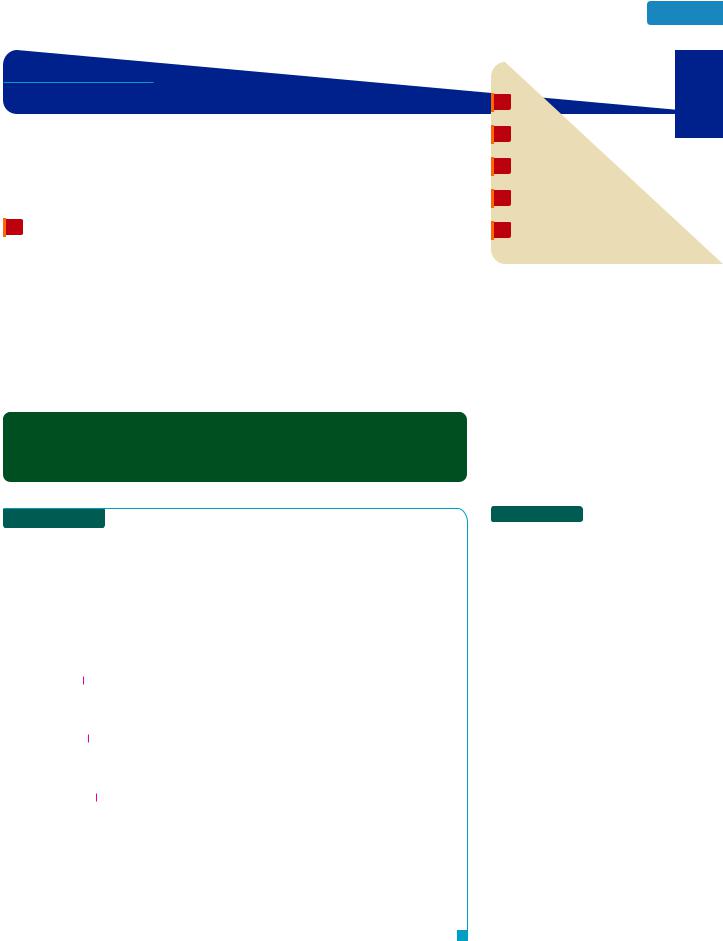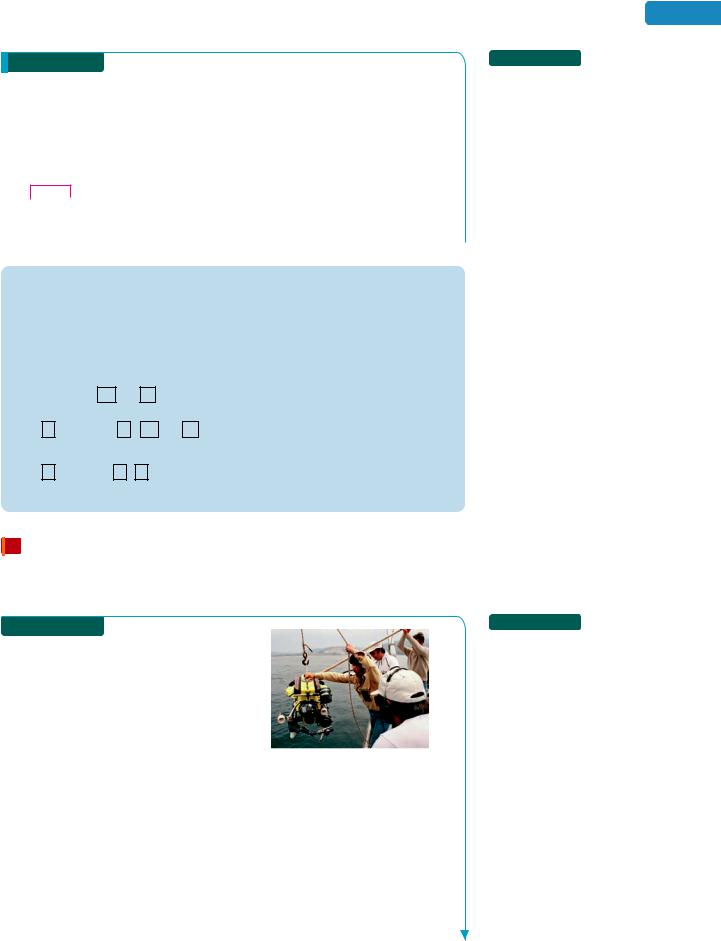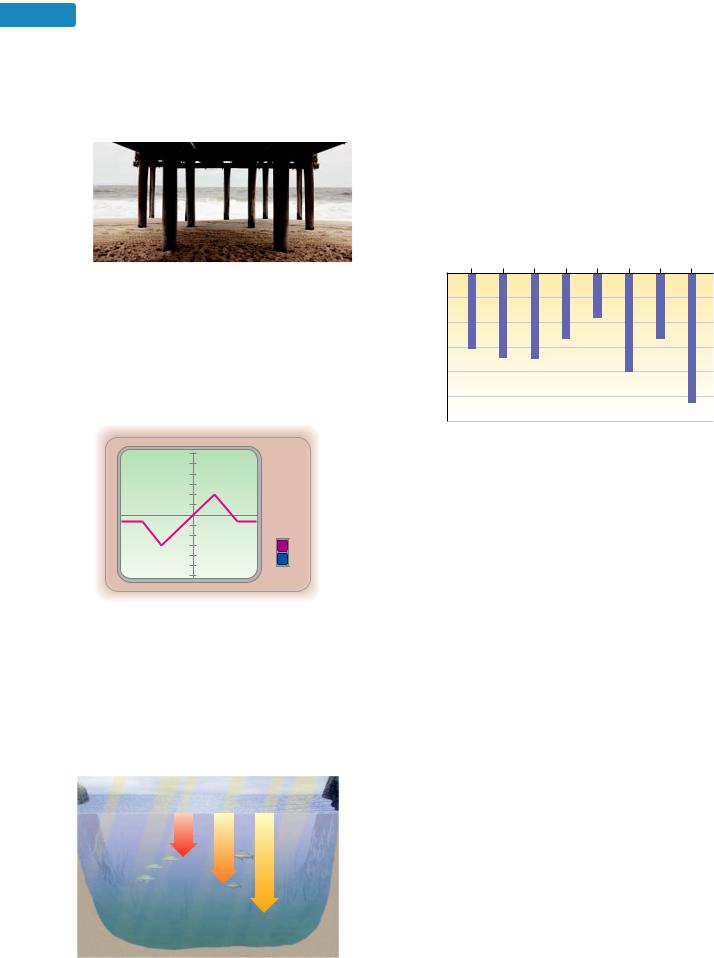
- •Study Skills Workshop
- •1.1 An Introduction to the Whole Numbers
- •1.2 Adding Whole Numbers
- •1.3 Subtracting Whole Numbers
- •1.4 Multiplying Whole Numbers
- •1.5 Dividing Whole Numbers
- •1.6 Problem Solving
- •1.7 Prime Factors and Exponents
- •1.8 The Least Common Multiple and the Greatest Common Factor
- •1.9 Order of Operations
- •THINK IT THROUGH Education Pays
- •2.1 An Introduction to the Integers
- •THINK IT THROUGH Credit Card Debt
- •2.2 Adding Integers
- •THINK IT THROUGH Cash Flow
- •2.3 Subtracting Integers
- •2.4 Multiplying Integers
- •2.5 Dividing Integers
- •2.6 Order of Operations and Estimation
- •Cumulative Review
- •3.1 An Introduction to Fractions
- •3.2 Multiplying Fractions
- •3.3 Dividing Fractions
- •3.4 Adding and Subtracting Fractions
- •THINK IT THROUGH Budgets
- •3.5 Multiplying and Dividing Mixed Numbers
- •3.6 Adding and Subtracting Mixed Numbers
- •THINK IT THROUGH
- •3.7 Order of Operations and Complex Fractions
- •Cumulative Review
- •4.1 An Introduction to Decimals
- •4.2 Adding and Subtracting Decimals
- •4.3 Multiplying Decimals
- •THINK IT THROUGH Overtime
- •4.4 Dividing Decimals
- •THINK IT THROUGH GPA
- •4.5 Fractions and Decimals
- •4.6 Square Roots
- •Cumulative Review
- •5.1 Ratios
- •5.2 Proportions
- •5.3 American Units of Measurement
- •5.4 Metric Units of Measurement
- •5.5 Converting between American and Metric Units
- •Cumulative Review
- •6.2 Solving Percent Problems Using Percent Equations and Proportions
- •6.3 Applications of Percent
- •6.4 Estimation with Percent
- •6.5 Interest
- •Cumulative Review
- •7.1 Reading Graphs and Tables
- •THINK IT THROUGH The Value of an Education
- •Cumulative Review
- •8.1 The Language of Algebra
- •8.2 Simplifying Algebraic Expressions
- •8.3 Solving Equations Using Properties of Equality
- •8.4 More about Solving Equations
- •8.5 Using Equations to Solve Application Problems
- •8.6 Multiplication Rules for Exponents
- •Cumulative Review
- •9.1 Basic Geometric Figures; Angles
- •9.2 Parallel and Perpendicular Lines
- •9.3 Triangles
- •9.4 The Pythagorean Theorem
- •9.5 Congruent Triangles and Similar Triangles
- •9.6 Quadrilaterals and Other Polygons
- •9.7 Perimeters and Areas of Polygons
- •THINK IT THROUGH Dorm Rooms
- •9.8 Circles
- •9.9 Volume
- •Cumulative Review

S E C T I O N 2.4
Multiplying Integers
Multiplication of integers is very much like multiplication of whole numbers.The only difference is that we must determine whether the answer is positive or negative.
When we multiply two nonzero integers, they either have different signs or they have the same sign. This means that there are two possibilities to consider.
1 Multiply two integers that have different signs.
To develop a rule for multiplying two integers that have different signs, we will find 4( 3), which is the product of a positive integer and negative integer. We say that the signs of the factors are unlike. By the definition of multiplication, 4( 3) means that we are to add 3 four times.
4( 3) ( 3) ( 3) ( 3) ( 3) Write 3 as an addend four times.
12 Use the rule for adding two integers that have the same sign.
The result is negative.As a check, think in terms of money. If you lose $3 four times, you have lost a total of $12,which is written $12.This example illustrates the following rule.
Multiplying Two Integers That Have Different (Unlike) Signs
To multiply a positive integer and a negative integer, multiply their absolute values. Then make the final answer negative.
|
EXAMPLE 1 |
Multiply: |
a. 7( 5) b. |
20( 8) c. 93 16 d. 34(1,000) |
|
Strategy We will use the rule for multiplying two integers that have different (unlike) signs.
WHY In each case,we are asked to multiply a positive integer and a negative integer.
Solution |
|
|
|
|
|
|||
a. Find the absolute values: |
07 0 7 and 0 5 0 5. |
|
|
|
||||
7( 5) 35 |
Multiply the absolute values, 7 and 5, to get 35. |
|
|
|
||||
|
|
|
Then make the final answer negative. |
|
|
|
||
|
|
|
|
|
|
|
||
|
|
|
|
|
|
|
||
b. Find the absolute values: |
020 0 20 and 0 8 0 8. |
|
|
|
||||
20( 8) 160 |
Multiply the absolute values, 20 and 8, to get 160. |
|
|
|
||||
|
|
Then make the final answer negative. |
|
|
|
|||
|
|
|
|
|
|
|
||
|
|
|
|
|
|
|
||
c. Find the absolute values: |
0 93 0 93 and 016 0 16. |
|
|
|
||||
93 16 1,488 |
Multiply the absolute values, 93 and 16, to get 1,488. |
|
93 |
|||||
|
||||||||
|
Then make the final answer negative. |
|
16 |
|||||
|
|
|
|
|
||||
|
|
|
|
|
||||
|
|
|
|
|
|
|
558 |
|
|
|
|
|
|
|
|
|
930 |
|
|
|
|
|
|
|
1,488 |
|
|
|
|
|
|
|
|
||
d.Recall from Section 1.4, to find the product of a whole number and 10, 100, 1,000, and so on, attach the number of zeros in that number to the right of the whole number. This rule can be extended to products of integers and 10, 100, 1,000, and so on.
34(1,000) 34,000 Since 1,000 has three zeros, attach three 0’s after 34.
2.4 Multiplying Integers |
165 |
Objectives
1Multiply two integers that have different signs.
2Multiply two integers that have the same sign.
3Perform several multiplications to evaluate expressions.
4Evaluate exponential expressions that have negative bases.
5Solve application problems by multiplying integers.
 Self Check 1
Self Check 1
Multiply:
a.2( 6)
b.30( 4)
c.75 17
d.98(1,000)
Now Try Problems 21,25,29,and 31

166 |
Chapter 2 The Integers |
Caution! When writing multiplication involving signed numbers, do not write a negative sign next to a raised dot (the multiplication symbol). Instead, use parentheses to show the multiplication.
6( 2) 6 2 and 6( 2) 6 2
2 Multiply two integers that have the same sign.
To develop a rule for multiplying two integers that have the same sign, we will first consider 4(3), which is the product of two positive integers.We say that the signs of the factors are like. By the definition of multiplication, 4(3) means that we are to add 3 four times.
4(3) 3 3 3 3 Write 3 as an addend four times.
12 |
The result is 12, which is a positive number. |
As expected, the result is positive.
To develop a rule for multiplying two negative integers, consider the following list, where we multiply 4 by factors that decrease by 1. We know how to find the first four products. Graphing those results on a number line is helpful in determining the last three products.
This factor decreases |
|
|
Look for a |
||
by 1 each time. |
|
|
|
|
pattern here. |
|
|
|
|||
|
|
|
|||
4(3) 12
4(2) 8
4(1) 4
4(0) 0
4( 1) ?
4( 2) ?
4( 3) ?
–12 |
–8 |
–4 |
0 |
? |
? |
? |
A graph of the products
From the pattern, we see that the product increases by 4 each time. Thus,
4( 1) 4, 4( 2) 8, and 4( 3) 12
These results illustrate that the product of two negative integers is positive. As a check, think of it as losing four debts of $3. This is equivalent to gaining $12. Therefore,4( $3) $12.
We have seen that the product of two positive integers is positive, and the product of two negative integers is also positive. Those results illustrate the following rule.
Multiplying Two Integers That Have the Same (Like) Signs
To multiply two integers that have the same sign, multiply their absolute values. The final answer is positive.

EXAMPLE 2 Multiply:
a. 5( 9) b. 8( 10) c. 23( 42) d. 2,500( 30,000)
Strategy We will use the rule for multiplying two integers that have the same (like) signs.
WHY In each case, we are asked to multiply two negative integers.
Solution |
|
|
|
|
|
a. Find the absolute values: |
0 5 0 5 and 0 9 0 9. |
|
|
|
|
5( 9) 45 |
Multiply the absolute values, 5 and 9, to get 45. |
|
|
|
|
|
The final answer is positive. |
|
|
|
|
b. Find the absolute values: |
0 8 0 8 and 0 10 0 10. |
|
|
|
|
8( 10) 80 |
Multiply the absolute values, 8 and 10, to get 80. |
|
|
|
|
|
The final answer is positive. |
|
|
|
|
c. Find the absolute values: |
0 23 0 23 and 0 42 0 42. |
|
|
|
|
23( 42) 966 |
Multiply the absolute values, 23 and 42, to get 966. |
|
42 |
||
|
|||||
|
The final answer is positive. |
|
23 |
||
|
|
|
|
126 |
|
|
|
|
|
840 |
|
|
|
|
|
|
966 |
|
|
|
|
||
d.We can extend the method discussed in Section 1.4 for multiplying wholenumber factors with trailing zeros to products of integers with trailing zeros.
2,500( 30,000) 75,000,000 Attach six 0’s after 75.
Multiply 25 and 3 to get 75.
We now summarize the multiplication rules for two integers.
Multiplying Two Integers
To multiply two nonzero integers, multiply their absolute values.
1.The product of two integers that have the same (like) signs is positive.
2.The product of two integers that have different (unlike) signs is negative.
Using Your CALCULATOR Multiplication with Negative Numbers
At Thanksgiving time, a large supermarket chain offered customers a free turkey with every grocery purchase of $200 or more. Each turkey cost the store $8, and 10,976 people took advantage of the offer. Since each of the 10,976 turkeys given away represented a loss of $8 (which can be expressed as $8), the company lost a total of 10,976( $8). To perform this multiplication using a calculator, we enter the following:
Reverse entry: |
10976 |
|
8 |
/ |
|
|
|
|
|
87808 |
||
Direct entry: |
10976 |
|
|
|
|
8 |
|
|
|
|
|
|
|
|
( ) |
|
|
ENTER |
|
87808 |
|||||
The negative result indicates that with the turkey giveaway promotion, the supermarket chain lost $87,808.
3 Perform several multiplications to evaluate expressions.
To evaluate expressions that contain several multiplications, we make repeated use of the rules for multiplying two integers.
2.4 Multiplying Integers |
167 |
 Self Check 2
Self Check 2
Multiply:
a.9( 7)
b.12( 2)
c.34( 15)
d.4,100( 20,000)
Now Try Problems 33,37,41,and 43

168 |
Chapter 2 The Integers |
 Self Check 3
Self Check 3
Evaluate each expression:
a.3( 12)( 2)
b.1(9)( 6)
c.4( 5)(8)( 3)
Now Try Problems 45, 47, and 49
|
EXAMPLE 3 |
Evaluate each expression: |
a. 6( 2)( 7) |
b. 9(8)( 1) c. 3( 5)(2)( 4) |
|
Strategy Since there are no calculations within parentheses and no exponential expressions, we will perform the multiplications, working from the left to the right.
WHY This is step 3 of the order of operations rule that was introduced in Section 1.9.
Solution
a. 6( 2)( 7) 12( 7) |
Use the rule for multiplying two integers that have |
1 |
12 |
||
|
different signs: 6( 2) 12. |
7 |
84 |
Use the rule for multiplying two integers that have |
84 |
|
||
|
the same sign. |
|
b. 9(8)( 1) 72( 1) Use the rule for multiplying two integers that have different
|
signs: 9(8) 72. |
72 |
Use the rule for multiplying two integers that have the same |
|
sign. |
c. 3( 5)(2)( 4) 15(2)( 4) |
Use the rule for multiplying two integers that have |
|
|
the same sign: 3( 5) 15. |
|
30( 4) |
Use the rule for multiplying two integers that have |
|
|
the same sign: 15(2) 30. |
|
120 |
Use the rule for multiplying two integers that have |
|
|
different signs. |
|
|
|
The properties of multiplication that were introduced in Section 1.3, Multiplying Whole Numbers, are also true for integers.
 Self Check 4
Self Check 4
Use the commutative and/or associative properties of multiplication to evaluate each expression from Self Check 3 in a different way:
a.3( 12)( 2)
b.1(9)( 6)
c.4( 5)(8)( 3)
Now Try Problems 45, 47, and 49
Properties of Multiplication
Commutative property of multiplication: The order in which integers are multiplied does not change their product.
Associative property of multiplication: The way in which integers are grouped does not change their product.
Multiplication property of 0: The product of any integer and 0 is 0.
Multiplication property of 1: The product of any integer and 1 is that integer.
Another approach to evaluate expressions like those in Example 3 is to use the properties of multiplication to reorder and regroup the factors in a helpful way.
 Use the commutative and/or associative properties of multiplication to evaluate each expression from Example 3 in a different way:
Use the commutative and/or associative properties of multiplication to evaluate each expression from Example 3 in a different way:
a. 6( 2)( 7) b. 9(8)( 1) c. 3( 5)(2)( 4)
Strategy When possible, we will use the commutative and/or associative properties of multiplication to multiply pairs of negative factors.
WHY The product of two negative factors is positive.With this approach, we work with fewer negative numbers, and that lessens the possibility of an error.
Solution
a. 6( 2)( 7) 6(14) Multiply the last two negative factors to produce a |
|
2 |
|
14 |
|
positive product: 7( 2) 14. |
|
6 |
84 |
|
84 |
|
||
|
|

b. 9(8)( 1) 9(8) Multiply the negative factors to produce a positive product: 9( 1) 9.
72
c. 3( 5)(2)( 4) 15( 8) |
Multiply the first two negative factors to produce |
|
4 |
|
|
|
15 |
|
|||
|
|
a positive product. Multiply the last two factors. |
|
8 |
|
120 |
Use the rule for multiplying two integers that |
|
120 |
|
|
|
|
||||
|
|
|
|||
|
EXAMPLE 5 Evaluate: |
have different signs. |
|
|
|
|
|
|
|
||
|
|
|
|
||
|
a. 2( 4)( 5) b. 3( 2)( 6)( 5) |
|
|
|
|
|
|
|
|
||
Strategy When possible, we will use the commutative and/or associative properties of multiplication to multiply pairs of negative factors.
WHY The product of two negative factors is positive.With this approach, we work with fewer negative numbers, and that lessens the possibility of an error.
Solution
a.Note that this expression is the product of three (an odd number) negative integers.
2( 4)( 5) 8( 5) Multiply the first two negative factors to produce a positive product.
40 The product is negative.
b.Note that this expression is the product of four (an even number) negative integers.
3( 2)( 6)( 5) 6(30) Multiply the first two negative factors and the last two negative factors to produce positive products.
180 The product is positive.
Example 5, part a, illustrates that a product is negative when there is an odd number of negative factors. Example 5, part b, illustrates that a product is positive when there is an even number of negative factors.
Multiplying an Even and an Odd Number of Negative Integers
The product of an even number of negative integers is positive.
The product of an odd number of negative integers is negative.
4 Evaluate exponential expressions that have negative bases.
Recall that exponential expressions are used to represent repeated multiplication. For example, 2 to the third power, or 23, is a shorthand way of writing 2 2 2. In this expression, the exponent is 3 and the base is positive 2. In the next example, we evaluate exponential expressions with bases that are negative numbers.
EXAMPLE 6 Evaluate each expression: a. ( 2)4 b. ( 5)3 c. ( 1)5
Strategy We will write each exponential expression as a product of repeated factors and then perform the multiplication. This requires that we identify the base and the exponent.
WHY The exponent tells the number of times the base is to be written as a factor.
2.4 Multiplying Integers |
169 |
 Self Check 5
Self Check 5
Evaluate each expression:
a.1( 2)( 5)
b.2( 7)( 1)( 2)
Now Try Problems 53 and 57
 Self Check 6
Self Check 6
Evaluate each expression:
a.( 3)4
b.( 4)3
c.( 1)7

170 |
Chapter 2 The Integers |
|
|
Now Try Problems 61, 65, and 67 |
Solution |
|
|
|
|
a. We read ( 2)4 as “negative two raised to the fourth power” or as “the fourth |
|
|
|
power of negative two.” Note that the exponent is even. |
|
|
|
( 2)4 ( 2)( 2)( 2)( 2) Write the base, 2, as a factor 4 times. |
|
|
|
4(4) Multiply the first two negative factors and the last two negative |
|
|
|
|
factors to produce positive products. |
|
|
16 |
The result is positive. |
|
|
b. We read ( 5)3 as “negative five raised to the third power” or as “the third |
|
|
|
power of negative five,” or as “ negative five, cubed.” Note that the exponent |
|
|
|
is odd. |
|
( 5)3 ( 5)( 5)( 5) Write the base, 5, as a factor 3 times.
25( 5) |
Multiply the first two negative factors to produce a |
|
2 |
|
25 |
||
|
positive product. |
|
5 |
125 |
The result is negative. |
|
125 |
|
|||
|
|
c. We read ( 1)5 as “negative one raised to the fifth power” or as “the fifth power of negative one.” Note that the exponent is odd.
( 1)5 ( 1)( 1)( 1)( 1)( 1) Write the base, 1, as a factor 5 times.
1(1)( 1) Multiply the first and second negative factors and multiply the third and fourth negative factors to produce positive products.
1 The result is negative.
In Example 6, part a, 2 was raised to an even power, and the answer was positive. In parts b and c, 5 and 1 were raised to odd powers, and, in each case, the answer was negative. These results suggest a general rule.
Even and Odd Powers of a Negative Integer
When a negative integer is raised to an even power, the result is positive.
When a negative integer is raised to an odd power, the result is negative.
Although the exponential expressions ( 3)2 and 32 look similar, they are not the same. We read ( 3)2 as “negative 3 squared” and 32 as “the opposite of the square of three.” When we evaluate them, it becomes clear that they are not equivalent.
( 3)2 |
|
|
32 |
|
|
|
|
( 3)( 3) Because of the |
(3 |
3) Since there are no |
|||||
|
|
|
parentheses, the |
|
|
|
parentheses around |
|
|
|
base is 3. The |
|
|
|
3, the base is 3. |
|
|
|
exponent is 2. |
|
|
|
The exponent is 2. |
|
9 |
|
|
9 |
|
||
|
|
|
|
||||
|
|
|
|
|
|
||
|
|
|
|
|
|
|
|
Different results
Caution! The base of an exponential expression does not include the negative sign unless parentheses are used.
73 |
( 7)3 |
|
V |
Positive base: 7 |
Negative base: 7 |

EXAMPLE 7 Evaluate: 22
Strategy We will rewrite the expression as a product of repeated factors, and then perform the multiplication. We must be careful when identifying the base. It is 2, not 2.
WHY Since there are no parentheses around 2, the base is 2.
Solution
22 |
|
|
|
|
(2 |
2) |
Read as “the opposite of the square of two.” |
|
|
|
4 |
|
Do the multiplication within the parentheses to get 4. |
|
|
|
|
Then write the opposite of that result. |
|
|
|
|
|
2.4 Multiplying Integers |
171 |
 Self Check 7
Self Check 7
Evaluate: 42
Now Try Problem 71
Using Your CALCULATOR Raising a Negative Number to a Power
We can find powers of negative integers, such as ( 5)6, using a calculator. The keystrokes that are used to evaluate such expressions vary from model to model, as shown below. You will need to determine which keystrokes produce the positive result that we would expect when raising a negative number to an even power.
5 |
|
/ |
|
|
yx |
|
6 |
|
|
|
|
|
|
|
Some calculators don’t require the parentheses |
|||||||||
|
|
|
|
|
|
|
|
|
|
|
|
|
|
|
|
|
|
|
|
|
|
to be entered. |
|
|
|
5 |
|
|
|
|
|
|
|
|
|
|
|
|
6 |
|
|
||||||||
( |
/ |
|
|
|
) |
|
|
yx |
|
|
Other calculators require the parentheses to be |
|||||||||||||
|
|
|
|
|
|
|
|
|
|
|
|
|
|
|
|
|
|
|
|
|
|
entered. |
|
|
|
|
|
|
|
|
5 |
|
|
|
|
|
|
|
|
6 |
|
|
|
|
|
|
|||
( |
|
|
( ) |
|
|
) |
|
|
^ |
|
ENTER |
|
15625 |
|||||||||||
From the calculator display, we see that ( 5)6 15,625.
5 Solve application problems by multiplying integers.
Problems that involve repeated addition are often more easily solved using multiplication.
|
EXAMPLE 8 |
Oceanography |
|
|
|
|
|
|
|
||
Scientists lowered an underwater vessel called |
|
|
|
||
a submersible into the Pacific Ocean to record |
|
|
|
||
the water temperature. The first measurement |
|
|
EmoryKristof/National Geographic/GettyImages |
||
was made 75 feet below sea level, and more |
|
|
|||
were made every 75 feet until it reached the |
|
|
|||
ocean floor. Find the depth of the submersible |
|
|
|||
when the 25th measurement was made. |
|
|
|||
Analyze |
|
|
|
|
|
|
• The first measurement was made 75 feet below sea level. |
Given |
|||
|
• More measurements were made every 75 feet. |
Given |
|||
|
• Find the depth of the submersible when it made the 25th |
|
|
||
|
measurement. |
Find |
|||
Form If we use negative numbers to represent the depths at which the measurements were made, then the first was at 75 feet. The depth (in feet) of the submersible when the 25th measurement was made can be found by adding 75 twenty-five times. This repeated addition can be calculated more simply by multiplication.
 Self Check 8
Self Check 8
GASOLINE LEAKS To determine how badly a gasoline tank was leaking, inspectors used a drilling process to take soil samples nearby. The first sample was taken 6 feet below ground level, and more were taken every 6 feet after that. The 14th sample was the first one that did not show signs of gasoline. How far below ground level was that?
Now Try Problem 97

172 |
Chapter 2 The Integers |
We translate the words of the problem to numbers and symbols.
The depth of the |
|
|
|
|
|
|
the number of |
|
the amount it |
||
submersible when |
is equal to |
times |
|||
c |
measurements |
was lowered |
|||
it made the 25th |
|
made |
|
each time. |
|
measurement |
|
|
|||
|
|
|
|
||
|
|
|
|
|
|
The depth of the |
|
|
|
|
|
submersible when it |
|
25 |
|
( 75) |
|
made the 25th |
|||||
|
|
|
|
||
measurement |
|
|
|
|
Solve To find the product, we use the rule for multiplying two integers that have different signs. First, we find the absolute values: 025 0 25 and 0 75 0 75.
25( 75) 1,875 Multiply the absolute values, 25 and 75, to get 1,875.
Since the integers have different signs, make the final answer negative.
7525 375 1 500 1,875
State The depth of the submersible was 1,875 feet below sea level ( 1,875 feet) when the 25th temperature measurement was taken.
Check We can use estimation or simply perform the actual multiplication again to see if the result seems reasonable.
|
ANSWERS TO SELF CHECKS |
|
|
|
|
|
|
|||
|
|
|
|
|
|
|
||||
|
1. |
a. 12 |
b. 120 c. 1,275 |
d. 98,000 |
2. a. 63 |
b. 24 c. |
510 |
d. 82,000,000 |
||
|
3. |
a. 72 |
b. 54 |
c. 480 |
4. a. |
72 b. 54 |
c. 480 |
5. a. 10 |
b. 28 |
6. a. 81 |
|
b. |
64 c. 1 |
7. 16 |
8. 84 ft below ground level ( 84 ft) |
|
|
||||
|
|
|
|
|
|
|
|
|
|
|
 S E C T I O N 2.4 STUDY SET
S E C T I O N 2.4 STUDY SET
 VOCABULARY
VOCABULARY
Fill in the blanks.
1.In the multiplication problem shown below, label each factor and the product.
|
5 |
|
10 |
|
|
|
|
50 |
|
|||||||
|
|
|
|
|
|
|
|
|
|
|
|
|
|
|
||
|
|
|
|
|
|
|
|
|
|
|
|
|
|
|
|
|
|
|
|
|
|
|
|
|
|
|
|||||||
2. |
Two negative integers, as well as two positive integers, |
|||||||||||||||
|
are said to have the same signs or |
|
|
signs. |
||||||||||||
3. |
A positive integer and a negative integer are said to |
|||||||||||||||
|
have different signs or |
|
|
signs. |
||||||||||||
4. |
|
|
|
|
|
property of multiplication: The order in |
||||||||||
|
which integers are multiplied does not change their |
|||||||||||||||
|
product. |
|
|
|
|
|
|
|
|
|
|
|
|
|
||
5. |
|
|
|
property of multiplication: The way in |
||||||||||||
|
which integers are grouped does not change their |
|||||||||||||||
|
product. |
|
|
|
|
|
|
|
|
|
|
|
|
|
||
6. |
In the expression ( 3)5, the |
|
|
|
|
is 3, and 5 is the |
||||||||||
|
|
. |
|
|
|
|
|
|
|
|
|
|
|
|
|
|
 CONCEPTS
CONCEPTS
Fill in the blanks.
7.Multiplication of integers is very much like multiplication of whole numbers. The only difference is that we must determine whether the answer is
or .
8. When we multiply two nonzero integers, they either have signs or sign.
9.To multiply a positive integer and a negative integer, multiply their absolute values. Then make the final
answer .
10.To multiply two integers that have the same sign, multiply their absolute values. The final answer is
.
11. |
The product of two integers with |
|
|
signs |
||
|
is negative. |
|
|
|||
12. |
The product of two integers with |
|
signs is |
|||
|
positive. |
|
|
|||
|
|
|
|
|
||
13. |
The product of any integer and 0 is |
|
. |
|
|
|

14. |
The product of an even number of negative integers |
||||
|
is |
|
and the product of an odd number of |
||
|
negative integers is |
|
. |
||
15. |
Find each absolute value. |
|
|||
|
a. 0 3 0 |
|
b. |
012 0 |
|
16.If each of the following expressions were evaluated, what would be the sign of the result?
a. ( 5)13 |
b. ( 3)20 |
 NOTATION
NOTATION
17.For each expression, identify the base and the exponent.
a. 84 |
b. ( 7)9 |
18.Translate to mathematical symbols.
a.negative three times negative two
b.negative five squared
c.the opposite of the square of five
Complete each solution to evaluate the expression.
19. 3( 2)( 4)  ( 4)
( 4)

20.( 3)4 ( 3)( 3)( 3) 
 (9)
(9)

 GUIDED PRACTICE
GUIDED PRACTICE
Multiply. See Example 1.
21. |
5( 3) |
22. |
4( 6) |
23. |
9( 2) |
24. |
5( 7) |
25. |
18( 4) |
26. |
17( 8) |
27. |
21( 6) |
28. |
39( 3) |
29. |
45 37 |
30. |
42 24 |
31. |
94 1,000 |
32. |
76 1,000 |
Multiply. See Example 2. |
|
|
|
33. |
( 8)( 7) |
34. |
( 9)( 3) |
35. |
7( 1) |
36. |
5( 1) |
37. |
3( 52) |
38. |
4( 73) |
39. |
6( 46) |
40. |
8( 48) |
41. |
59( 33) |
42. |
61( 29) |
43. |
60,000( 1,200) |
44. |
20,000( 3,200) |
Evaluate each expression. See Examples 3 and 4.
45. |
6( 3)( 5) |
46. |
9( 3)( 4) |
47. |
5(10)( 3) |
48. |
8(7)( 2) |
49. |
2( 4)(6)( 8) |
50. |
3( 5)(2)( 9) |
51. |
8( 3)(7)( 2) |
52. |
9( 3)(4)( 2) |
|
|
2.4 |
Multiplying Integers |
173 |
Evaluate each expression. See Example 5. |
|
|||
53. |
4( 2)( 6) |
54. |
4( 6)( 3) |
|
55. |
3( 9)( 3) |
56. |
5( 2)( 5) |
|
57. |
1( 3)( 2)( 6) |
58. |
1( 4)( 2)( 4) |
|
59. |
9( 4)( 1)( 4) |
60. |
6( 3)( 6)( 1) |
|
Evaluate each expression. See Example 6. |
|
|||
61. |
( 3)3 |
62. |
( 6)3 |
|
63. |
( 2)5 |
64. |
( 3)5 |
|
65. |
( 5)4 |
66. |
( 7)4 |
|
67. |
( 1)8 |
68. |
( 1)10 |
|
Evaluate each expression. See Example 7.
69.( 7)2 and 72
70.( 5)2 and 52
71.( 12)2 and 122
72.( 11)2 and 112
 TRY IT YOURSELF
TRY IT YOURSELF
Evaluate each expression.
73. |
6( 5)(2) |
74. |
4( 2)(2) |
75. |
8(0) |
76. |
0( 27) |
77. |
( 4)3 |
78. |
( 8)3 |
79. |
( 2)10 |
80. |
( 3)8 |
81. |
2( 3)(3)( 1) |
82. |
5( 2)(3)( 1) |
83.Find the product of 6 and the opposite of 10.
84.Find the product of the opposite of 9 and the opposite of 8.
85. |
6( 4)( 2) |
86. |
3( 2)( 3) |
87. |
42 200,000 |
88. |
56 10,000 |
89. |
54 |
90. |
24 |
91. |
12( 12) |
92. |
5( 5) |
93. |
( 1)6 |
94. |
( 1)5 |
95.( 1)( 2)( 3)( 4)( 5)
96.( 10)( 8)( 6)( 4)( 2)
 APPLICATIONS
APPLICATIONS
Use signed numbers to solve each problem.
97.SUBMARINES As part of a training exercise, the captain of a submarine ordered it to descend 250 feet, level off for 5 minutes, and then repeat the process several times. If the sub was on the ocean’s surface at the beginning of the exercise, find its depth after the 8th dive.

174 |
Chapter 2 The Integers |
98.BUILDING A PIER A pile driver uses a heavy weight to pound tall poles into the ocean floor. If each strike of a pile driver on the top of a pole sends it 6 inches deeper, find the depth of the pole after 20 strikes.
Image Source/Getty Images
99.MAGNIFICATION A mechanic used an electronic testing device to check the smog emissions of a car. The results of the test are displayed on a screen.
a.Find the high and low values for this test as shown on the screen.
b.By switching a setting, the picture on the screen can be magnified. What would be the new high and new low if every value were doubled?
5 |
Smog |
emission |
|
High |
testing |
|
|
|
Normal |
Low |
|
−5 |
Magnify |
|
|
|
2 |
100.LIGHT Sunlight is a mixture of all colors. When sunlight passes through water, the water absorbs different colors at different rates, as shown.
a.Use a signed number to represent the depth to which red light penetrates water.
b.Green light penetrates 4 times deeper than red light. How deep is this?
c.Blue light penetrates 3 times deeper than orange light. How deep is this?
Surface of water
|
|
|
|
R |
O |
|
|
|
|
|
E |
R |
Y |
|
|
|
||||
|
|
|
|
D |
A |
|
|
–10 |
|
|
E |
||
(ft) |
|
|
S |
N |
||
|
|
L |
||||
|
|
|
|
G |
||
water |
|
|
|
|
L |
|
–20 |
|
|
|
E |
||
|
|
|
W |
|||
of |
|
|
|
S |
O |
|
–30 |
|
|
|
|
S |
|
Depth |
|
|
|
|
|
|
|
|
|
|
|
||
–40 |
|
|
|
|
|
|
|
|
|
|
|
||
|
|
|
|
|
|
|
|
|
|
|
|
|
|
|
|
|
|
|
|
|
|
|
|
|
|
|
|
101.JOB LOSSES Refer to the bar graph. Find the number of jobs lost in . . .
a.September 2008 if it was about 6 times the number lost in April.
b.October 2008 if it was about 9 times the number lost in May.
c.November 2008 if it was about 7 times the number lost in February.
d.December if it was about 6 times the number lost in March.
2008 U.S. Monthly Net Job Losses
Jan. Feb. Mar. Apr. May June July Aug.
(inthousands) |
–25 |
|
|
–50 |
|
–47 |
|
–75 |
–67 |
–67 |
|
lost |
–76 |
–88 |
|
–83 |
|
||
jobs |
–100 |
|
–100 |
|
|
||
|
|
|
|
Net |
–120 |
|
|
|
|
–127 |
|
|
|
|
|
|
–150 |
|
|
Source: Bureau of Labor Statistics
102.RUSSIA The U.S. Census Bureau estimates that Russia’s population is decreasing by about 700,000 per year because of high death rates and low birth rates. If this pattern continues, what will be the total decline in Russia’s population over the next 30 years? (Source: About.com)
103.PLANETS The average surface temperature of Mars is 81°F. Find the average surface temperature of Uranus if it is four times colder than Mars. (Source:
The World Almanac and Book of Facts, 2009)
104.CROP LOSS A farmer, worried about his fruit trees suffering frost damage, calls the weather service for temperature information. He is told that temperatures will be decreasing approximately
5 degrees every hour for the next five hours. What signed number represents the total change in temperature expected over the next five hours?
105.TAX WRITE-OFF For each of the last six years, a businesswoman has filed a $200 depreciation allowance on her income tax return for an office computer system. What signed number represents the total amount of depreciation written off over the six-year period?
106.EROSION A levee protects a town in a low-lying area from flooding. According to geologists, the banks of the levee are eroding at a rate of 2 feet per year. If something isn’t done to correct the problem, what signed number indicates how much of the levee will erode during the next decade?
